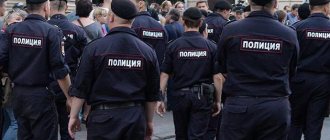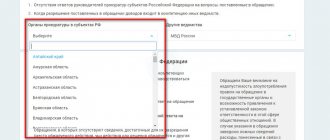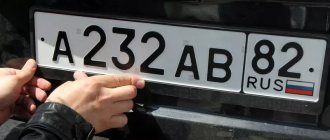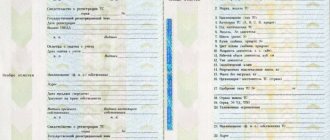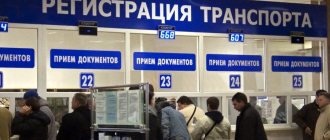Unfortunately, the legal literacy of the population still leaves much to be desired. And although the situation is still not as pessimistic as in Soviet times, strictly speaking, understanding all the intricacies of the legislation is the job of professional lawyers, given that laws change quite often. Especially when it comes to traffic rules: here even traffic police officers do not always keep up with all the innovations, let alone the average motorist.
Meanwhile, if you are stopped by a man in a police uniform with a baton in his hand, it is simply necessary to know your rights and responsibilities. And not only that, because there are many nuances here that indirectly affect the scenario of your communication with a representative of the authorities.
In principle, when stopping a vehicle, an inspector must be guided by certain procedural rules and administrative regulations, but in practice he often deviates from these norms, especially if he sees that the driver does not know how to behave and what rights he has.
We will try to outline all aspects concerning the actions of a car owner when a vehicle is stopped by a traffic police inspector.
Grounds for stopping a vehicle
Let's start with the basics - in what cases is it legal for a traffic police inspector to stop your car? This aspect is discussed in detail in Order No. 0185 of the Ministry of Internal Affairs of the Russian Federation (clause 063).
In particular, the grounds for such actions are the following reasons:
- you violated one of the traffic rules, and this violation was recorded by an inspector using special technical equipment (radar, video camera) or visually;
- if a government official has information about the possible involvement of the driver/owner of a vehicle or its passengers in an accident, if they are suspected of committing a criminal/administrative offense. The source of such information may be internal orientation, data transmitted to the duty officer, as well as testimony of ordinary citizens (for example, during an accident) or video data that recorded the moment the offense was committed;
- if the inspector has information indicating that the vehicle he stopped was stolen/is wanted. The source of such information may be the same orientations, operational data transmitted to the duty officers, etc.;
- if those in the car may be potential witnesses to an accident or any other offense/crime;
- if a representative of the authorities is looking for a witness, who should be an uninterested (random) person;
- for the traffic police inspector to carry out administrative and regulatory actions;
- if there is a need to provide a car for the needs of the traffic police or doctors;
- to provide emergency assistance to police officers during execution or to persons injured in road accidents, as well as when committing other offenses.
Please note that stopping a car to check the documents of everyone inside is allowed only at equipped traffic police posts (clause 063 paragraph 010 of the Order of the Ministry of Internal Affairs).
If the IDPS stopped you and did not want to voice the reason for stopping the vehicle (for example, the need to involve someone as a witness), you can safely refuse the request, much less the requirement to present documents outside the traffic police post. If the reason given is the presence of an orientation, you have the right to ask to see it for review. In case of refusal, you also do not have to show your documents.
Before giving advice to drivers who do not know how to talk to a traffic police inspector, we will describe where and how you can stop the car if you see a wave of the baton. First of all, you need to be sure that it is you who is being stopped. If in doubt, feel free to drive by, but look in the rearview mirror to see if the IDPS is waving after you.
Remember that you cannot stop anywhere - the traffic police officer must show you exactly where to park the car (point 065). You cannot stop in places where it is prohibited by appropriate markings and signs (paragraph 066). But there are exceptions:
- if the vehicle is stopped to prevent the commission of an offense;
- if there is a need to take administrative and regulatory actions;
- to prevent the threat (imaginary or real) of causing damage to the health/property of other participants in the DD;
- if the order to stop is given by a patrol car with sound/light signals on.
If a traffic police officer needs a car to perform urgent official duties, he must inform the driver of the route, the purpose of the trip, and also inform about responsibility if the car owner does not satisfy his request, and not get behind the wheel (only the driver should drive the car). If the stated purpose is the pursuit of persons who have committed crimes, you can refuse to provide your car - in accordance with paragraph 068, the pursuit is carried out only in a service vehicle.
A police officer may demand to give up his seat behind the wheel if, in accordance with paragraph 126 of the Administrative Regulations, the driver should be removed from driving a car.
If the driver is late for work due to the use of his car by a traffic police officer, he can ask the IDPS to issue the appropriate certificate, and also make a note in the PL indicating the duration of the trip, the distance covered by the car, his position, full name, name of the traffic police department, service ID number.
In certain situations, police officers can forcibly stop vehicles using:
- appropriate technical equipment (service weapons, stun guns, gas canisters, batons).
- giving special signals (traffic controller gestures, traffic lights) prohibiting movement;
- blocking the road by a patrol car with mandatory flashing lights turned on.
The procedure for stopping a car by a traffic police officer
The gesture of a traffic police officer must be understandable to the driver.
Unlike the old regulations, under the new document, traffic police officers are authorized to stop vehicles in any place, with the exception of areas where stopping is prohibited.
Automotive expert Igor Morzharetto spoke about this:
In the previous regulations, stopping outside stationary posts without a reason was formally prohibited.
But a dozen reasons were immediately given for why it could be stopped. For example, carrying out special operations or if the driver violated traffic rules. And now a traffic police officer will always find a reason to stop a car if he needs it. But if not, then drive freely. Igor Morzharetto
https://www.m24.ru/articles/avto/20102017/151269?utm_source=CopyBu
The traffic police officer must convey the request to stop to the driver in an understandable form - verbally or using gestures. In this case, the inspector must show exactly where the driver should stop.
For this the following can be used:
- speaker;
- rod or other device.
A whistle or some kind of light signal may be used to attract attention. The presence of a light signal is mandatory when stopping transport in the dark.
General rules for communicating with a traffic police inspector
Stopping a vehicle is not always associated with an obvious violation of traffic rules, although the opposite statement can also be said to be fair - it is unlikely that you can find at least one car that formally complies with all points of the Rules without exception. So in most cases, drivers are not aware of what caused the increased attention to their person or car from a traffic police officer.
Therefore, the first rule when communicating with a traffic police inspector is to ask why the car was stopped. This must be done in a polite manner in the form of an oral question, film the dialogue and wait for an answer.
If it seems too vague to you, if the inspector refers to some regulations that you do not know, ask to clarify the number of the specific document whose clauses you violated. If the reason for the stop remains unclear, it may well be considered illegal.
In addition to finding out the article of the Code of Administrative Offenses or the number of the traffic rules paragraph, in accordance with which you were stopped, you should find out what punishment is provided for this violation. The answer should also be recorded using your own means of recording, be it a voice recorder or a smartphone camera.
One of the basic rights of a driver when communicating with a traffic police inspector is to demand to see his or her service ID, and always in unfolded form. If they present you with something like a certificate rather than an official document, or even refuse to fulfill your request, you can safely leave the place of conflict (of course, if your conversation is captured on a digital medium).
You can also call 102 right on the spot and report illegal actions of an alleged traffic police officer, reporting the presence of a recorded conversation (or better yet, give it to them) and note that, fearing for your life, you did not comply with the requirements and left.
Find out the reason for the stop
The regulations state that the traffic police officer must first introduce himself and explain the reason for the stop.
There can be quite a few of them: from a registered traffic violation to a check of documents of the driver (license, insurance), passengers, or a raid being carried out.
An important nuance: the driver does not need to question the inspector; he must explain everything in detail himself.
Does the car owner need to get out of the car?
Since October 2021, a new administrative regulation of the Ministry of Internal Affairs of the Russian Federation came into force, which, although it regulated the actions only of traffic police officers and other law enforcement agencies, caused a lot of speculation and misunderstandings among the drivers, which were fueled by a not entirely professional interpretation of the regulatory document on the part of auto experts and even lawyers.
In particular, there is no clause in the administrative regulations that would allow drivers who are stopped to film the actions of law enforcement officers. In this regard, suspicions arose that such actions were indeed prohibited from now on, but it turned out that this was an incorrect interpretation.
Like another rumor - that in accordance with paragraph 093 of the same Order No. 664, drivers are required to get out of the car at the request of the IDPS. The document says the following about this: a traffic police officer may offer the driver to get out of the vehicle in the following cases:
- if the driver is found to have signs of alcohol intoxication and/or illness that makes driving difficult;
- to verify the vehicle component numbers with the data entered in the registration certificate (the procedure must be carried out in the presence of the car owner or driver);
- if the driver must take part in procedural actions, if his assistance is required regarding other participants in the traffic accident, or if assistance is required from traffic police officers;
- to eliminate a vehicle malfunction discovered by the inspector;
- in case of violation by the car owner of the rules for the transportation of goods;
- if the driver's behavior threatens the safety of a police officer.
However, there are no changes in this paragraph with respect to the previous version of the Order. And yet, a number of media outlets were quick to declare that drivers are now required to do so on demand. The official must immediately get out of the vehicle.
This is not entirely true. The fact is that the technical regulations literally state the following: “...an employee has the right to offer...”, that is, this is not a requirement at all. This means that the driver does not have counter-responsibilities, so he may well ignore the inspector’s words if he considers it necessary.
This is a direct and unambiguous answer to the question of how to behave if the car owner is stopped by a traffic police inspector. Moreover, this technical regulation refers to internal documents relating to police officers, and not ordinary road users.
However, subsections of Article 027 of the Code of Administrative Offenses still regulate cases when the driver will have to obey and leave the vehicle:
- when drawing up an administrative protocol on detention (Article 027.04);
- when drawing up a protocol on vehicle inspection (Article 027.09);
- when drawing up a protocol on the removal of a car owner from driving a vehicle (Article 027.12).
Rules of conduct for drivers when stopped by a traffic police officer
Drivers are strongly encouraged to comply with stop orders. The car will be stopped anyway: at the next checkpoint or using a patrol car. Ignoring this rule will not be considered in favor of the driver, and explanations like “didn’t see, didn’t understand, didn’t notice” will not correct the situation.
It is necessary to maintain a calm and polite behavior, without ingratiation or fussiness. There is no need to get out of the car without appropriate requests.
If the driver is stopped for the purpose of driving his car, then he just needs to come to terms with it and allow him to use the vehicle. Perhaps he himself will drive the car in the indicated direction.
How should a traffic police inspector address you?
The driver can ask the traffic police officer to show his ID to make sure that he is communicating with him.
As already mentioned, after stopping you need to calmly wait for the traffic police officer. He is obliged to introduce himself, that is, provide his last name, position, explain the reason for the stop and ask for documents. If the driver requests, the inspector must present his ID.
If we are talking about suspicion of an offense or involving traffic participants as witnesses or witnesses, their rights and obligations must be explained to them.
What a traffic police officer should not do
Here are the actions that are prohibited for employees:
- manifestation of rudeness, insult. The traffic police officer must also refrain from moralizing and inappropriate remarks;
- accepting money or other things and objects;
- stopping where prohibited, except in emergency circumstances;
- making notes on the driver’s documents, except in specially designated places for this;
- indication of non-existent facts in documents and any other falsification of papers.
Are documents always checked?
As a rule, any stop is accompanied by a document check. On the one hand, the inspector cannot demand documents without reason. Cases when this is allowed are specified in the mentioned regulations. On the other hand, the wording of paragraph 107 makes it possible to justify this requirement almost always. So, paragraph 107 allows you to check documents if:
- signs of violation by the driver of the rules have been identified or it is necessary to draw up a report on an administrative violation;
- is aware of document falsification;
- there is information about a possible crime committed by the driver or about his being on the wanted list.
The driver must not only show the documents, but also hand them over to the inspector. This requirement is also established by the traffic rules. In this case, the rights and other documents must be taken out of the cover; the documents themselves should not contain any money, pieces of paper, or anything else.
The inspector may limit himself to checking documents on the spot, or he may take them with him to the official car to clarify data about the traffic participant using automated databases. However, the inspector cannot withhold documents for a long time without reason. If the driver’s license is not returned for a long time, he can contact the employee and ask about the reasons for withholding the documents. A question about the department in which the employee works, as well as recording this conversation on video, may well play the role of an “accelerator”.
Is it possible to videotape or record a conversation with an inspector?
A lot of misunderstandings arise about the possibility of recording communications with an inspector on video or a voice recorder.
There is no provision in the regulations about prohibiting recording. However, a different principle of law enforcement often prevails in practice: everything that is not expressly permitted is prohibited. The head of the Federation of Car Owners of Russia, Sergei Kanaev, spoke about this:
“In the administrative regulations, the norm was removed so that traffic police officers would not interfere with video filming.
Previously, a traffic police officer did not have the right to prohibit filming. And now he can say: I forbid you to film yourself: I’m embarrassed. And you must remove the video camera. If you don’t remove it, you will face Article 19.3.” https://www.m24.ru/articles/avto/20102017/151269?utm_source=CopyBuf
The conclusion is this: the driver can record what is happening on video, but he will have to stop recording if the inspector directly objects.
Is it necessary to open the window or get out of the car when talking with the inspector?
Usually the conversation and checking of documents take place at the stop through an open car window. The driver does not have to get out of the car, but it is not prohibited.
You will have to get out of the car if the inspector asks you to do so. This is allowed if:
- the driver shows signs of using alcohol or other illegal substances;
- the driver's health is cause for concern;
- it is necessary to conduct an inspection of the vehicle or search the driver himself, check the engine or body numbers of the car with the data specified in the documents, or perform other procedural actions;
- driver assistance needed;
- there is a need to eliminate problems or irregularities in the transportation of goods;
- The driver's actions towards the inspector are threatening.
I had a situation a long time ago, I was driving from Novosibirsk to the region, and 20 kilometers before the checkpoint a traffic cop ran out of the bushes, waving a stick, I ignored it and drove on.
I didn't see his car. In short, at the checkpoint they stopped me, and I simply explained that I didn’t see the car, maybe they were filthy bandits, dressed in uniform, and I had valuable cargo with me)) They checked my documents, laughed at me and let me go. And if on topic, if I see a crew with a car that does not arouse suspicion, I always stop, get out of the car MYSELF and, bidding farewell to the inspector, wish him all the best. You need to be kinder and not be a bully. Sanych from Novosibirsk
https://forums.drom.ru/law/t1152458199-p3.html
Driver's rights during vehicle inspection
An inspection is a procedural action, the procedure of which is determined by Article 27.9 of the Code of Administrative Offenses of the Russian Federation.
First of all, you need to know that a traffic police officer can carry out this action only with witnesses or using video recording.
The purpose of the search is to search for items related to the violation of the law. For example, there may be illegal substances (drugs) or stolen valuables in the car. All details of the interrogation are reflected in the protocol.
During the inspection, the driver in the protocol should fill in all empty columns with dashes, indicate his comments and sign
You must understand that search and inspection are different procedures. During the inspection, the employee visually inspects the vehicle. Witnesses or video recording are not required. But, if an employee begins to independently open doors and touch objects, then this is already an inspection. In such a situation, lawyer Marat Amanliev advises the following:
The driver himself must also film all the actions of the inspector.
Insist that the police examine the car step by step. That is, it wasn’t just the two of them rummaging around in the cabin, but first they opened one door, looked, then closed it, opened the next one, and so on. This is the only way to guarantee that something suspicious will not be planted in your car: drugs, ammunition, whatever. https://www.gazeta.ru/auto/2018/06/26_a_11815297.shtml
Procedure for testing for alcohol consumption
During any stop, the traffic police inspector pays attention to the condition of the driver. At the slightest suspicion of alcohol intoxication, the presence of alcohol or other prohibited substances should be checked.
The examination can take two forms:
- on site by a traffic police officer using a special device;
- in the form of a medical examination in a medical institution.
Any condition check must be documented. Based on the results of the inspection, a report is drawn up.
A report is drawn up and in the event of a driver’s refusal to undergo an on-site inspection
Examination by blood test for alcohol content is not always carried out. The reason for sending the driver to a medical facility is:
- his disagreement with the results of the on-site inspection;
- if the driver refused to be checked by an inspector;
- if the result of the on-site test is negative and there are obvious signs of intoxication.
An inspector can send a driver to a medical facility only after a portable breathalyzer test has been carried out or if the driver has been offered such a test and he has refused. Referral for a medical examination in violation of the specified sequence is illegal.
The driver is legally required to undergo a condition check if required by an inspector. However, this requirement must be fulfilled voluntarily; coercion is not used. In this case, refusal is qualified as an independent offense provided for in Article 12.26 of the Code of Administrative Offenses. For such stubbornness, you can not only become poorer by 30 thousand rubles, but also lose your driver status for 1.5–2 years.
Video: examination during arrest
Reasons for detaining and delivering the driver and passengers to the station
In the worst case scenario, the driver may even be detained and sent to the police station.
Detention is a serious measure for which there must be compelling reasons. Such a basis is the commission of a crime and the involvement of traffic participants in it.
Upon arrest, the inspector must inform the duty officer about this, after which an investigative team should be called to the place of detention or an instruction to deliver the offenders to the police.
It is necessary to distinguish from detention the forced transfer of a person to the police station. You have to resort to this measure if:
- it is impossible to draw up a protocol on the spot;
- liability for unlawful actions of the driver provides for administrative arrest. In this case, we are talking about administrative detention;
- if it is necessary to establish an identity and there are suspicions that the citizen is wanted;
- it is necessary to resolve the issue of detention and it is difficult at the place where the car is stopped;
- this is necessary for the safety of the citizen in the event of a threat to his life and health and if he cannot take care of himself;
In this case, the citizen is delivered to the police station in a patrol car or his own car, but control is transferred to the inspector.
Does the inspector have the right to demand payment of a fine on the spot?
Often stopping a car ends with a decision on an administrative violation. Indeed, under some articles of the Code of Administrative Offenses, which, as a rule, provide for minor violations, the inspector can independently bring the violator to justice and impose punishment. This is allowed if the punishment involves a fine or warning and the driver agrees with everything.
But if the driver does not agree with the fact of the violation, a protocol must be drawn up and sent to the traffic police department for consideration. In this case, no decision will be made.
A fine is a punishment that requires the offender to pay a certain fixed amount to the budget. You can pay the fine at a bank branch, post office, through terminals, as well as special Internet services (mobile applications, a single portal of government services).
There is no provision for paying a fine on the spot. Any transfer of money to an official may be qualified as a bribe.
The inspector should only provide information about how and where the fine can be paid.
Let us remind you that when paying a fine no later than 20 days after the decision is made, the violator saves half the amount established by the relevant article of the Code of Administrative Offences.
Other rights of drivers when a car is stopped by an inspector
It would be useful for any driver to know about his rights.
Let us dwell on those rights that were not mentioned earlier:
- if we are talking about registering an administrative offense, the inspector must explain to the driver his rights and obligations;
- the driver or his fellow travelers can familiarize themselves with the procedural documents drawn up in relation to them;
- the alleged violator can and should make explanations if he disagrees with the protocol. You should not think that refusing to sign the protocol can somehow protect you. To act wisely, the protocol must be read carefully and in case of reasoned disagreement or any comments, be sure to indicate this in the protocol itself, and then sign it. Only in this case will your comments be taken into account and may somehow affect the consideration of the case or appeal;
- participants in the proceedings have the right to a copy of the protocol, which is handed to them by default.
In 22 years, they have never stopped me just to get to the bottom of it; if there were stops, it was for an obvious violation of traffic rules or just a document check \ a complete sobriety test raid.
It never occurred to me to challenge the legality of the stop, because there is nothing easier than stopping for 2 minutes, talking to the inspector and moving on. Rowan Atkinson
https://forums.drom.ru/law/t1152458199-p3.html
Video: driver’s rights when drawing up a protocol by a traffic police officer
Is it necessary to get into the inspector’s car at his request?
In general, a request or requirement to move into the car of a traffic police officer to perform procedural actions is not mandatory. With the only exception - when the inspector informs the driver about the interception plan - it is no longer possible to refuse. Moreover, there is no need to show aggression either, because this can be regarded as a threat. But you have the right to demand to see documents in approximately the same sequence as we have already described.
If you are asked to go into a traffic police car to draw up a protocol on committing an administrative violation, you may not agree - the regulatory framework does not stipulate the place for drawing up such documents. However, such a request from a government representative is also not illegal, but you are not obliged to fulfill it. Typically, this technique is used to psychologically influence the offender, but you can refuse to proceed to the traffic police vehicle, referring to paragraph 035 of the Code of Administrative Offenses, which states that any actions related to the implementation of any procedural actions, including paperwork, must be carried out on the spot committing an administrative violation, except for the cases described in paragraphs 0109, 0131, 0187, 0193, 0216 of the administrative regulations. It is allowed to register in a patrol car or in the premises of a traffic police post, but in this context the word “allowed” is not considered as an imperative that must be followed.
That is, the legal basis for the car owner to follow into the patrol car is only the detention of the culprit of the offense. In case of arrest on suspicion of committing a crime, the police officer is obliged to read to the detainee the rights and obligations provided for in paragraph 0197 of the Code of Administrative Offenses, with the corresponding entries being entered into the protocol.
However, if you do not want to comply with the request to change seats, your refusal should be presented in a mild form. You shouldn't be rude to a traffic police officer. Moreover, if you do not have any special reasons to stay in your car, and if you do not have the desire to verbally argue with a representative of the authorities, you may well comply, because it does not make much difference where the protocol is drawn up. The main thing is that you be careful when reading the protocol. These are the basic rules for communicating with a traffic police inspector.
Of course, if a car owner knows that the punishment for an administrative violation provided for by law is quite severe, he may be tempted to solve the problem with minimal financial losses, that is, simply put, to “agree” with the inspectors. And doing this is much easier and, to a certain extent, safer in a traffic police car.
Recently, there has been an active fight against such non-protocol actions. In particular, DVRs are installed in all patrol cars, so there is no longer any point in inviting the driver into a company car.
But you also have the right to record a conversation with the IDPS using available technical means, so in any case, the risk of ending up in the role of a bribe-taker means for you the possibility of going to jail. The official will not want to take risks either, especially since recently inspectors have been equipped with lapel recorders.
So it makes no difference for either the driver or the traffic police officer where exactly to conduct the conversation or draw up an administrative protocol.
You have the right to remain silent—or to provide an explanation.
We are driven to commit many traffic violations not by the desire to “go crazy,” but by some circumstances. For example, in order to avoid a collision with another car, you crossed a double continuous lane. This fact may become a mitigating circumstance or allow you to avoid a fine altogether. You can explain what is happening as you see fit, and the inspector is obliged to listen to you and record your explanations in the protocol. If before signing you did not see your explanations in the protocol or if they are inaccurate, feel free to enter your explanations in a special column yourself.
The inspector demands an explanation, but you don’t want to explain anything? You have the right! Refer to Article 51 of the Constitution, according to which no one is obliged to testify against himself, his spouse and close relatives.
How to behave in case of violation
So, we list the main recommendations when stopping your car by a traffic police inspector:
- If the violation is minor and there is a possibility that the problem will be resolved by issuing a warning, you should definitely try to implement this plan. Argue as convincingly as possible that you were forced to commit a violation by insurmountable life circumstances, that you did this for the first time in your life and promise never to do this again;
- if it was not possible to persuade a representative of the authorities to limit yourself to a verbal warning, when drawing up the protocol, use your right to point out circumstances that testify in your favor;
- if the inspector insists that you have committed an offense, demand from him evidence of your guilt - a verbal description is not enough to find you guilty;
- remember that you have the right to bring as a witness any person who was in your car at the time of the stop, even if it is a close relative, including your spouse;
- be sure to record the conversation using a cell phone or DVR - even if you make a mistake, the recording can be deleted;
- It is also advisable to record all the circumstances surrounding the vehicle stop: road conditions, the presence/absence of road signs, signs, markings, as well as objects that interfere with normal visibility on a specific section of the highway.
Powers of inspectors
The procedure for performing duties by traffic police officers is prescribed in Order of the Ministry of Internal Affairs No. 185. Many car owners ask the question: Does the inspection representative have the right to demand that the driver leave the car? The employee has the right to ask for this, but whether to fulfill the request or not is the driver’s right, not his responsibility.
The order to stop is given by the inspector using a loudspeaker or a baton with a whistle. It is the responsibility of the inspection officer to accurately point at the car with a baton. If the rod does not point to the car, the driver has the right to continue driving.
Where can I stop the vehicle? According to the Traffic Rules, this must be a well-lit road or traffic police post. When stopping a car on the road, the clothing of a traffic police officer must contain reflective details. If the procedure for stopping a vehicle is violated, the car owner has the right to appeal the inspector’s actions to management or through the court.
How to behave when drawing up a protocol
While the inspector is preparing the protocol, you can sit quietly in the car. As soon as the protocol is transferred to you for review, you can take the following actions:
- clarify whether all information relating to the offense is included in the document. Be sure to check this, and if any important details are missing, ask to fill them in;
- inform the IDPS that you intend to apply for a change in the time interval during which your case will be considered;
- the protocol form contains a note that you are familiar with the claims, the place and time of the consideration of the case. Apply your signature only if you have actually been made aware of this information. Otherwise, add to the protocol that you are not familiar with it;
- If you believe that the information stated by the inspector in the protocol is not true, you have the opportunity to make an appropriate entry: “I do not agree, I did not commit a traffic violation. Since I need legal assistance, I request that the deadline for consideration of the case be postponed for a period of at least three days”;
- Regardless of the degree of relationship, everyone in the car can be included in the administrative protocol as witnesses - the inspector has no right to refuse the car owner this;
- if you believe that a traffic police representative put pressure on you or made threats, you have the right to display this in the protocol;
- you can record what is happening on camera, but traffic police representatives have the same rights. If they were also involved in video recording, indicate this fact in the protocol, along with the brand and number of the recording device;
- the protocol is drawn up in two copies. Remember that one of them is yours and should not be given/transferred to anyone.
What are they checking on foreigners?
Stateless persons or foreign drivers can be checked:
- Identity passport or other similar document.
- Migration documents, foreign visa.
- Driver license.
- Vehicle documentation, customs papers when importing a vehicle from abroad.
- Insurance policy or other document that is similar to compulsory motor liability insurance according to international rules.
- Entry documents, permits.
A foreigner who is a passenger, a pedestrian, or has no citizenship may be checked for a migration card, visa, passport, entry documents, or permits to visit the region.
In what cases can you not stop at the request of the IPDS?
Here you need to understand that, while in a car, you cannot know why the baton was waved at you, that is, you cannot assess the legality of the stop.
Meanwhile, cases when stopping a vehicle is legal are prescribed by law, that is, the instructors themselves know when it is possible to stop and when it is not. Drivers, in principle, can also know this, but in a particular case they will have to stop, at least until the circumstances are clarified.
However, here too there are nuances that allow you to drive past a traffic police officer waving his baton. They concern, first of all, the place where cars stop. Permissible are stationary traffic police posts, as well as roads adjacent to the main section.
You can also stop your car on the side of the road, but in this case the list of situations that allow you to take such a step is very limited:
- if the vehicle violated traffic rules;
- if your car is described as similar to the one in the guide and is listed as stolen;
- if there is suspicion that those in the car have committed a crime.
Otherwise, stopping the car on the roadway is prohibited, and such actions by traffic police officers may be regarded by higher authorities as an obvious violation of internal discipline, requiring punishment of the perpetrators.
Let's consider cases when you don't have to stop at the request of the inspector:
- if the attempt was made at night outside the stationary post;
- in cases where a forced stop of a vehicle in the current traffic situation threatens its safety and threatens an emergency;
- if the requirement to stop is presented on a section of the highway with limited visibility (before/after turns, steep ascents/descents), at intersections or in front of traffic lights, in other potentially dangerous places.
Here it doesn’t matter why you are stopped, since the traffic police officer himself violates the instructions, creating the preconditions for an accident to occur.
You have the right not to give up your driver's license.
Remember that the basis for confiscation of a driver’s license is only the execution of a court verdict that has entered into legal force, or a decision in an administrative offense case on deprivation of the right to drive a vehicle. After the resolution comes into force, the driver has three working days to submit the license himself; otherwise, the period of deprivation will be extended and an additional fine will have to be paid.
This rule is established by paragraph 221 of the Regulations, and it is intended to put an end to the long-standing practice of confiscating a driver’s license at the scene of a stop.
A few words about the video recording of the conversation with the traffic police inspector
Among the changes made to the administrative regulations and which came into effect on October 10, 2017, there is no clause 25, which existed previously, which stated that traffic police officers were prohibited from preventing drivers or passengers from videotaping a conversation when stopping a vehicle and drawing up a protocol.
Here again, talk arose about infringement of the rights of car owners. In reality, there is actually no ban on filming a conversation, but using such a recording as evidence in a trial will be a problem. In addition, one should take into account the requirements of Article 19.03 of the Administrative Code, which talks about the possibility of prohibiting filming by an inspector under certain circumstances. It all depends on how you talk to the traffic police inspector - if in a rude manner, then you should not expect any concessions.
On the other hand, recently the traffic police officers themselves have been video recording a conflict situation, and the violator does not have the levers to prohibit such filming.
The right to stop the movement of vehicles
Decree of the Government of Russia No. 716 dated August 19, 2013 prescribes the conditions and algorithm for car stops, the rights and responsibilities of government agencies vested with this authority, the time at which traffic police officers change shifts, as well as the legal protection of persons driving vehicles.
So, the vehicle has the right to stop:
- Adjuster;
- Representative of the Federal Service for Supervision of Transport;
- Traffic police inspector;
- Police officer.
There must be a good reason for stopping - just checking documents is not enough.
Is it possible to pay the fine on the spot?
Currently, there are many ways to pay a fine, most of which are carried out on the basis of a receipt received by the violator. But you can pay off the debt on the spot, which will save you from the need to take any additional actions. If you completely agree with the claims made by the traffic police inspector and do not intend to dispute them, you can ask to write out a receipt instead of drawing up a protocol. True, such an opportunity exists if the fine does not exceed 100 rubles. Traffic police officers must have mobile cash registers with them, through which debt repayment is carried out. In this case, the driver is given a payment receipt, printed immediately.
Study the protocol and take a copy
The driver should carefully study the protocol and indicate on it which points he does not agree with. At the end of the protocol, “signature of the violator” may be written. It would be correct to cross out the word “violator” and replace it with “driver.”
You need to put a dash in the “Witnesses” column so that traffic cops are not tempted to write them in there. The driver must have a copy of the protocol in his hands.
Illegal actions of traffic police officers
We have already noted which documents should be presented to the inspector and under what conditions. But if he doesn’t return the document to you, gets into a patrol car and drives away, this is a violation that can be classified as robbery. It must be recorded at the nearest police department, provided that you have information about the employee who committed this offense.
There is another situation: the inspector took the documents and does not return them for a long time, without drawing up a protocol on the violation, thereby provoking you to give a bribe. In this case, you should call the duty station using the helpline number, reporting the circumstances of your vehicle stop. You will need to indicate the inspector's full name, his rank, and the license plate number of the patrol car. When talking about the unlawful actions of a government official, indicate what charges were brought against you, say that the employee left with the documents and is not taking any action. Report that you do not intend to leave the car because you are afraid that illegal actions will be taken against you by the crew of the patrol car.
Usually the inspector is contacted and the situation is resolved. If after a certain time no visible changes have occurred, call again.
When this doesn’t help, you still have to leave the car to record your conversation with the inspector on camera. You approach the traffic police car and loudly and clearly ask him to start drawing up a protocol, informing him that you will not agree with its wording. Also ask for the documents back.
If the inspector ignores your requirements, call 102 and explain the situation. They may tell you that the delay is due to checking your car in the traffic police database, but this is just an excuse - let the employee check as much as necessary, but he must hand over the documents.
In the most difficult cases, when none of the above actions have brought results, the only option remains: to write a statement to the Prosecutor's Office, complaining that the official has exceeded his official duties.
Request witnesses or video recording during inspection
Car inspection includes not only a visual inspection, but also a thorough check of the interior (opening doors, examining objects, etc.).
That is why the inspection is a procedural procedure and requires the presence of witnesses or video recording. This will protect the driver from illegal actions of traffic police officers (for example, planting drugs or ammunition).
What is prohibited?
The driver of a vehicle is prohibited from the following actions:
- You cannot drive while intoxicated or under the influence of medications that impair attention and reaction; in a tired or ill state that threatens traffic safety.
- You cannot take a place in organized columns and cross them.
- It is prohibited to transfer control of a vehicle to persons who are intoxicated, under the influence of medications that impair attention and reaction, in a tired or painful state, or who do not have a driver’s license of the appropriate category. The exception is cases of driving lessons.
- You cannot use a phone while driving that is not equipped with a device that allows hands-free conversations.
- It is also prohibited to drive transport in violation of the work and rest schedule.
It is worth noting that the driver’s rights when stopped by the traffic police do not include the use of narcotic, alcoholic and other intoxicating substances after an accident. We are talking about the period of time until the examination is carried out or until a decision is made to release a person from this procedure.
Amnesty for drivers
Drivers who have been deprived of their license may be “pardoned.” Amnesty means complete exemption from administrative or criminal punishment. It is executed by publishing a special resolution by an authorized government body. Consequently, this decision is not issued for any reason, but in cases provided by law for the possibility of issuing an amnesty.
The Criminal and Criminal Procedure Codes have their own instructions on the action in question. Its concept, procedure and consequences of publication are regulated in articles and other legal acts. Thus, the issue of granting an amnesty is being considered by the State Duma of the Russian Federation. After this, a resolution is introduced to announce the decree.
The Code of Administrative Offenses provides for the possibility of amnesty. But it does not stipulate the order of its publication. That is, there is no indication of the body making the decision on the amnesty, or the legal basis for its announcement. Therefore, drivers who have been deprived of their license and are expecting leniency cannot hope for this. But they have the legal right to appeal the court's decision.
Features of drawing up some protocols on traffic violations
There are offenses for which traffic inspectors like to attract drivers first, or in cases where there is nothing else to “catch on to.” Therefore, it is worth knowing how to behave in such cases and try not to bring the matter to the point of drawing up a report and subsequent payment of a fine. What violations are we talking about?
- Unfastened seat belt. If the traffic police inspector does not have irrefutable evidence that you were not wearing a seat belt while driving, then you can always refer to the fact that the belt was unfastened immediately after stopping. That is, during the time the inspector walked to the car. And let him try to prove the opposite;
- Over speed. A technically sound radar should serve as evidence of a violation of the speed limit on the road. It should clearly show that the measured speed refers specifically to the vehicle that was stopped, and the readings themselves were taken immediately before the stop. If this data is not available, then you can safely challenge the inspector’s decision to draw up a protocol for speeding;
- Dirty rooms. Although, in accordance with technical regulations, including GOST 50577-93, it is impossible to drive a car with dirty license plates, it is quite difficult to record this violation. License plates are considered unreadable if at night they are not visible from a distance of 20 meters, even in the light of a traffic inspector’s flashlight. That is, in order to issue a fine, it is necessary to create exactly such conditions. In practice, this is not always possible, so usually road inspectors, instead of issuing a fine, only ask to wipe the license plates.
Forklift drivers
Forklift driver's license - what is it? The license for a loader is a tractor driver’s license of categories B, C and D. Documents are issued by Gostekhnadzor. For this purpose, special courses are organized for training or retraining of forklift drivers. Then certification is carried out, exams are passed and a certificate is obtained from Gostekhnadzor upon presentation of the necessary documents.
Thus, we have considered all the factors that a person who is about to get behind the wheel of a vehicle must know. You must be able to defend your rights in any situation if there is an attempt to infringe them. It is also necessary to remember that ignorance of legal norms does not exempt the person who violated them from responsibility. Be careful on the road!
